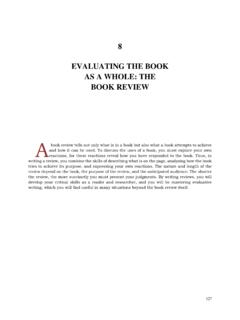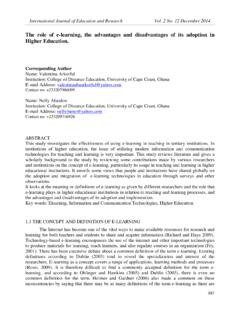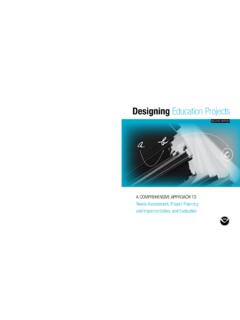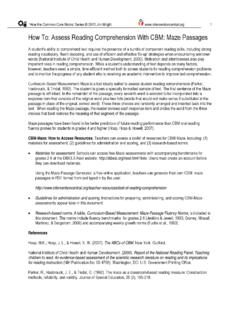Transcription of Curriculum Mapping: The Game Plan
1 Curriculum Mapping: The Game PlanPrepared by:Dr Shirley MappingA process for collecting data thatidentifies: - content- thinking processes- assessment to improve communication and instruction in all areas of the Curriculum . Define CurriculumTypes of Curriculum Recommended Standards as defined by experts in their field. Written national standards, local goals and objectives (ie. MLCs) Supported Curriculum for which materials are actually available, such as textbooks and does it offer a school? A Curriculum map is useful in: helping teachers understand what is taught and when in all subject areas and all grade levels assisting teachers in creating unified interdisciplinary units that foster students understanding of concepts, ideas, and activities across many subject areas helping coordinate areas of study into larger interdisciplinary units (even if they are assessed separately by subject area)A Curriculum map is useful in.
2 Acting as a successful venue for fostering conversation about Curriculum and instruction among all faculty members assisting the students in finding "common threads" of understanding between a specific academic subject and other subjects assisting teachers in reflecting upon and adjusting their own lesson units during the school yearA Curriculum map help identify seams and gaps identify repetition within scope and sequence allow vertical and horizontal alignment of assessments content and methods across subjects and grade levels improve both Curriculum delivery and assessmentContents: A Useful Successful mapping system is: adaptable to school-specific content and categories; available to all faculty anywhere, anytime platform independent (all computers can view and use) easily updated by individuals supportive of communication: links to faculty e-mail addresses/discussion groups relevant to a school s goals, mission and standards.
3 Searchable by: Specific subject, specific teacher, specific course General subject area Grade Assessment strategy Essential questions, Standards applied, relevance to goals and objectives Day, Month, Year, trimester, semester, quarter Teaching tools, methods (hardware, software, projects,products, hands-on, strategies) Skills General and specific lesson contentExampleWhat is Curriculum Mapping? Curriculum Mapping is the documentation and discussion of what we teach. It is a collaborative process that helps us understand teaching and learning throughout of Curriculum Assessed What is actually assessed at the state and local level. Taught The content that teachers actually deliver.
4 Intended The written district guide for grade level Curriculum Mapping? It benefits ALL students. Mapping is a COMMUNICATION tool . Mapping is a PLANNING tool , it keeps us FOCUSEDand targets necessary information. PromotesPROFESSIONALISMand teaching Mapping is not burdensome, in fact it replaces repeat teachings and (eventually) lesson plans. Mapping allows us to focus on fewer goals, and therefore, teach concepts in depth. Mapping will eliminate wasted review and expand teaching time. It horizontally and vertically shows Curriculum MappingAttempts to: Create a snapshot of the educational activities of every classroom within the school.
5 Capture the content skills and assessments taught by every teacher in the school. Organize this information into an easily accessed visual that presents a timeline of instruction by teacher and s Curriculum MapEssential QuestionsContent/ActivitiesOutcomesAsses smentStandardsEnglishFilipinoSocial StudiesMathScienceEssential Focus on a broad topic of study. Have multiple answers and perspectives. They address why or how . They are mental Velcro that helps ideas stick in students QuestionsExamples Which is more important water or air? What is change? What if Shakespeare was a woman?Content can be shaped in different formats Interdisciplinary: combination of two or more disciplines to examine a common focus.
6 Student Centered: content is focused on investigation of student generated interests derived from their personal interests and Cultural diversity Water cycle Federal Government System Fire SafetyOutcomes Outcomes are key abilities and processes students will develop related to specific content. Outcome Examples Reading a map Writing a play Analyzing non-fiction text Writing persuasive essays Matching words and picturesAssessment Assessments are the products or performances that demonstrate student learning. Assessments are what the student does (the actual product or performance), not the evaluation tool used to assess the Examples Group presentation Brochure Research Paper Essay exam Puppet show DebateActivities Key activities that lead to acquisition of knowledge and skills.
7 Describe the "how" for the knowledge and skills. Activities Examples Writing persuasive letters to local government Water analysis of local river Critique a work of art Create a new gameOnce we have our Maps, what do we do with them?Edit, audit, update, and create development tasks. Gain information Avoid repetition Identify gaps Identify potential areas for integration Examine for timelines Edit for coherenceGain information Underline every place in the map where you learned something new about the operational Curriculum . This expands the teacher s understanding of his/her students for Repetitions Recognize the difference between repetitions and redundancy.
8 Spiraling as a for Gaps Examine maps for gaps in: Content Thinking processes and skills Assessments Locate potential areas for integration Peruse the map and circle areas for integration of content, skills, and assessment. These can serve as the springboard for Curriculum for timeliness Review the maps for timely issues, breakthroughs, methods , materials, and new types of assessment. Be vigilant about for Coherence Scrutinize maps for a solid match between the choice of content, the featured skills and processes, and the type of PHASE 1: collecting the data PHASE 2: first read-through PHASE 3: small mixed group review PHASE 4: large group comparisons PHASE 5: determine immediate revision points PHASE 6: determine points requiring some research and planning PHASE 7: plan for next review cyclePHASE 1: Collecting the Data Each teacher in completes a map.
9 The format is consistent for each teacher, but reflects the individual nature of each classroom. Technology simplifies data Content Data Types of focus: * Configuration Topics- Discipline-based field Issues- Interdisciplinary Works- Student-centered Problems Themes PHASE 2: First Read-Through Each teacher reads the entire school map as an editor and carries out the tasks . Places where new information was gained are underlined. Places requiring potential revision are circled. (repetitions, gaps, etc.)PHASE 3: mixed -Small Group Groups of 5 to 8 faculty members are formed. Groups should be from diverse configurations ( different grade levels and departments) The goal is to simply share individual findings.
10 No revisions are 4: Large Group Review All faculty members come together and examine the compilation of findings from the smaller groups. Session is facilitated by principal and/or teacher 5: Determine areas for immediate revision The faculty identifies those areas that can be handled by the site with relative ease. The specific faculty members involved in those revisions determine a timetable for 6: Determining those areas requiring long term planning Faculty members identify those areas that have implications beyond the site with other sites. Faculty members identify those areas where research is 7: The Cycle Continues Meet 3 times annually for review.






